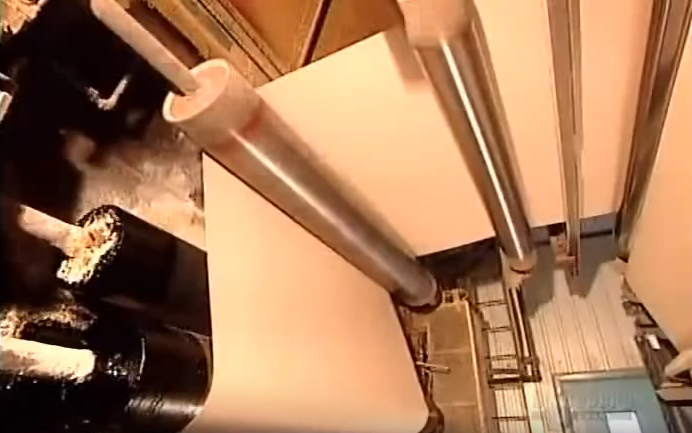Roofing production lines, like most large manufacturing process lines, rely on rolls, gears, motors, chains, drums, and cutters that must all work in unison to produce a quality finished product. Precision alignment – meaning level to earth and perpendicular or square to the overall machine centerline – in the major sections of the line will improve the life expectancy of components, reduce waste and product quality issues as well as, improve the line’s overall runnability.
In this post, we provide an overview of some common misalignment symptoms and the probable causes to watch for in your roofing manufacturing line.
Dry End Loopers or Accumulators
Dry End Loopers that consist of pull rolls, pipes, chains and sprockets, or Accumulators that consist of pull rolls, a stationary lower level of rolls, and a floating upper level of rolls, allow for the matt (substrate) to accumulate in this section so that the entire production process can continue during matt roll changes.
Misalignment symptoms and possible causes to be aware of in the dry end loopers include:
- Substrate tracking issues, either entering or exiting the dry end looper, are indicators of pull rolls that may be scissored and/or not perpendicular to the overall machine centerline.
- Tracking issues may also be an indication of the two chain runs (front and back) being out of time with each other.
- Premature and/or excessive wear of sprocket teeth, chain guides, and the chains themselves, can be attributed to the looper frame not being level, square, or straight. It can also be caused by the sprocket shafts being out of level and square.
Misalignment symptoms and possible causes to be aware of in the dry end accumulators include:
- Substrate tracking issues entering, passing through, or exiting the dry end accumulator are indicators of pull rolls that may be scissored and/or not perpendicular to the overall machine centerline.
- Tracking issues may also be an indication of individual rolls on the lower or upper levels of the accumulator that are out of level and square.
- Tracking issues may also be an indicator that (with respect to their level conditions) the upper level of the accumulator is not parallel with the lower level.
Coaters

Fiberglass matt runs through rolls during production
The coating section is where the matt is saturated with hot liquid asphalt as it moves through a series of rolls. Symptoms of misalignment in the coating section will commonly appear as web tracking issues and coating inconsistencies. The probable causes for these symptoms will be misalignment of one or more of the rolls within the coater section.
Slate and Sand Drums
Once the matt is coated, it is pulled through two large drums where the slate granules and sand are applied and pressed into the matt. Possible misalignment symptoms will appear as web tracking issues and uneven embedding of the granules and sand into the matt. As there is a great deal of “wrap” around these two drums, it is very important that they are aligned level and square in order to avoid serious tracking issues.
Cooling Section
The cooling section consists of a series of water filled chill rolls oriented on an upper and lower level. The top rolls of the cooling section are normally driven. When misalignment is present in the cooling section, symptoms include web tracking issues, premature bearing failures and uneven product cooling. It is important to note that the slate and sand granules can cause excessive roll surface wear and misalignment of the individual rolls will multiply this effect.
Finish Loopers
Finish Loopers, similar to the dry end loopers, consist of pull rolls, pipes, chains and sprockets and allow for the finished product to accumulate in this section so that the entire production line process can continue during handling of the finished product at the winder/cutter end of the line. Misalignment symptoms and possible causes to be aware of in the finish loopers are very similar to those already listed in the dry end looper section.
The Roll Winder and/or the Anvil Cutter
The Roll Winder, if misaligned, will most likely result in uneven tension in the individual rolls and/or noticeable offsets or telescoping on the ends of the individual rolls.
Misalignment within the Anvil Cutter will commonly result in improper cuts of shingles and/or notches and possibly shingle breakage and tears.
Alignment inspection data of anvil and cutter rolls captured with a laser tracker and metrology software
Stackers
Misalignment within the previously mentioned sections can often lead to issues in the stacking section such as uneven stacks, jamming and component wear.
Conclusion
With the many rolls and other components in a roofing line, proper alignment of the components plays a key function in producing high quality product and reducing waste and unplanned downtime. In order to prevent costly issues, it is recommended that not only regular alignment inspections be conducted, but machine maintenance problems be inspected for and addressed before they become expensive problems.
OASIS has helped numerous roofing manufacturers reduce waste and improve machine performance with the precision alignment of their components. If you would like a site visit to your facility to discuss alignment related issues you may be having, please contact the OASIS Service Center nearest you.
